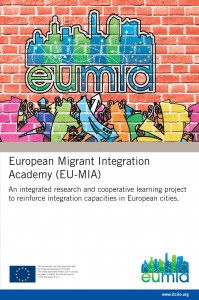What works in integration? How is it done? And who does it well?
 These are questions that we aim to explore in the research project titled ‘European Migrant Integration Academy – an integrated research learning project to reinforce integration capacities in European cities’. Yes, I agree, it is a very long and cumbersome title (I still need to look it up), so we usually stick to EU-MIA.
These are questions that we aim to explore in the research project titled ‘European Migrant Integration Academy – an integrated research learning project to reinforce integration capacities in European cities’. Yes, I agree, it is a very long and cumbersome title (I still need to look it up), so we usually stick to EU-MIA.
EU-MIA is an EU-funded project led by the Turin-based training centre of the International Labour Organisation (ITC-ILO), and with COMPAS and FIERI – a Turin-based research centre – as partners. The aim of the project is to collect a catalogue of best practices for integration from a selection of European cities. This research will culminate in an Academy, a 10-day training course, for public officials and other local stakeholders, where experiences are shared in order to raise standards and successes of integration practices across Europe. The Academy will be held in February 2014.
The significant aspect of EU-MIA is the link between research and learning. At present, there is a growing body of work at the interface of research and policy, but training policy-makers and practitioners is an underdeveloped area, and this is where we hope EU-MIA will ‘fill the gap’ by providing practical, practitioner-oriented training based on scholarly research. EU-MIA seeks to work with municipalities to document promising practices in integration, and subsequently use these in order to develop training materials. We do not hope to find perfect models of integration policy which can be adopted wholesale across different city contexts, but we believe there is a wealth of effective work carried out at city level across Europe, often in partnership with civil society organisations, and despite diminishing resources.
Where we are now
The main aim of this preliminary research stage is to identify and document ten ‘functioning practices’ in different EU countries. Each of the practices will be the target of a ‘field mission’ where we over a five day period will be interviewing and filming different stakeholders and beneficiaries. The research will thus provide a platform for the reflective voices of both practitioners and beneficiaries. Subsequently the material from the ‘missions’ will provide the basis for the training academy in Turin.
Most of our work so far has been focused on establishing an overview over the field of integration in different parts of the EU. This is a time consuming and not always very satisfactory task, as the data base we end up with is contingent on the quality and organisation of documentation that is made available online. We are also aware that a full picture of integration practices is an illusion, even though some EU countries operate with platforms that serve to organise the documentation of integration projects.
 Our aim is to focus on innovative practices across a number of different policy fields – for example employment, education, active citizenship, etc. But whereas it is relatively straightforward to identify the policy field(s) that are related to the implementation of specific practices, the innovative aspect poses a very different challenge because of the multifarious nature of the integration process – and the very diverse political and cultural contexts where integration is understood and interpreted. So what may seem innovative in one local or national context may be a tried and tested practice in another country.
Our aim is to focus on innovative practices across a number of different policy fields – for example employment, education, active citizenship, etc. But whereas it is relatively straightforward to identify the policy field(s) that are related to the implementation of specific practices, the innovative aspect poses a very different challenge because of the multifarious nature of the integration process – and the very diverse political and cultural contexts where integration is understood and interpreted. So what may seem innovative in one local or national context may be a tried and tested practice in another country.
Similarly, our understanding of integration as a dynamic process that involves both majority and minority populations may or may not resonate with approaches on the ground in different national contexts. We have here decided to adopt a broad approach and ensured that we include practices that target the entire population as well as practices that only involve immigrants and ethnic minority groupings. Furthermore, we aim to include both big cities and smaller urbanisations (fewer than 100.000 inhabitants) in the final sample.
In order to maximise our reach and also, if possible, get in touch with practitioners who did not surface during the desk research, we designed and distributed a survey monkey, thus enabling practitioners to self-nominate practices. The survey monkey thus provided a very useful additional pathway, providing a total 170 practices and relevant baseline data.
We have right now finalised a ‘long list’ of approximately 20 practices in different EU countries, and we will over the next few weeks be boiling this down to the final 10 practices. Over the period from April to August, the field missions will subsequently take place. This is, as far as I am concerned, the most interesting part of the project, as we get to meet and interview stakeholders and beneficiaries in the different cities, and experience the probably very diverse cultural and social contexts where projects have been implemented. We at COMPAS will be focusing on five practices in northern Europe, whereas FIERI will be doing five field missions in southern Europe. We will be sharing our findings from the missions later in the year – sooooo, watch this space!